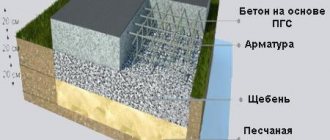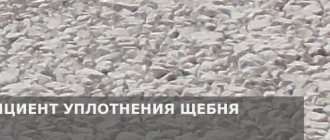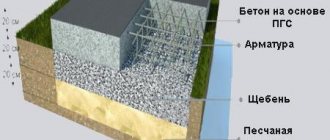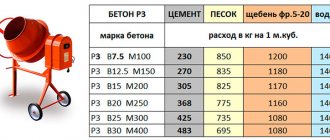When constructing foundations, blind areas, bases for paths and roads, sidewalks and laying communications, various combinations of soil, sand, crushed stone, gravel and secondary gravel are used. In this case, the mixtures are necessarily compacted and compacted, which implies a certain compaction coefficient, which must be known to accurately calculate the material.
Typical preparation of the base for a monolithic or block foundation in section
On average, data on the compaction coefficients of the most popular materials is presented in Table 1.
| Material and its technical characteristics | Compaction factor |
| Crushed stone fraction 40-70, grade 800 fraction 70-120, grade 800 all fractions, grade 300…600 | Average 1.1 1,25…1,3 1,25…1,3 1,1…1,5 |
| Slag, depending on density | 1,3…1,5 |
| Construction sand | 1,15 |
| Soil, depending on type | 1,1…1,4 |
| PGS | 1,2 |
| Expanded clay | 1,15 |
However, these are general, average data. Let's take a closer look at where the concept of compaction coefficient comes from and how to determine it.
Materials used
For different types of foundations, it can use both local compacted soil and imported materials. Most often, local semi-rocky and sandy soils are subjected to compaction. Already loams, and even more so clayey soils, must be removed to the depth of the pit and replaced with a cushion of sand and gravel.
In this case, the base layers must be subjected to compaction, the effectiveness of which depends on the following factors:
- layer material. For crushed stone of different types, gravel, gravel-sand mixture (GSM) and sand, the compaction coefficient is very different;
- fractions of material. The larger the fragments, the more difficult it is to compact them;
- tamping method - manual, mechanized - and the force applied;
- height and total volume of the backfilled layer;
- the presence of material with a grain size less than that specified by the lower limit of this class (for example, for crushed stone of fraction 5...20, the content of stone up to 3 mm in size inclusive is about 5% - such a discrepancy will have little effect on the degree of compaction. If the percentage is ¼...1/4 volume – adjustments will have to be made);
- flakiness (for crushed stone). This parameter expresses the ratio of the content of cuboidal stones to flat ones. The lower the flakiness, the more cubic elements and the more densely the crushed stone can be compacted;
- layer moisture.
Quality standards, fractions and other parameters of crushed stone are regulated by GOST 8267-93 for crushed stone and GOST 8736-2014 for construction sand.
Accordingly, the degree of compaction of any bulk material, expressed by a dimensionless coefficient, depends on the type of material and operating conditions.
Ways to increase soil density
The characteristics of the soil depend on its composition and humidity. If its density is very low, there is a tendency to deformation and subsidence. These are highly compressible peat, silt, sapropels, plastic clays, etc. In most cases they are not used as foundations for construction. It is necessary to increase their strength properties, which can be solved using various methods:
- injection of fixing solutions;
- heat treatment (firing);
- electrochemical method;
- reinforcement;
- installation of sheet piling;
- filter loading;
- mechanical methods.
If the surface density of the soil is insufficient, the top layer is compacted using tampers, rollers, and area vibrators. Deep compaction is carried out using piles, vibration, soaking, and directed explosions. At high humidity, the groundwater level first decreases, then preliminary compression is carried out.
What is transportation compaction factor
This name refers to the ratio of the volume of material at the time of loading the vehicle to the volume at the time of delivery.
Taking into account the fact that during transportation bulk material is inevitably compacted - road shaking plays the role of compaction - the minimum acceptable coefficient for accepting crushed stone, sand or sand-gravel mixture delivered to the site is considered to be 1.1. That is, data on the volume of the body (car, other transport capacity), multiplied by a factor of 1.1, must match the ordered volume or slightly exceed it. If the resulting figure is less than the required one by 2...5% or more, it is necessary to resolve the issue of shortage of material.
Example.
20 cubic meters of crushed stone were ordered, 18 cubic meters were delivered. (according to measurements from the inside of the body). Taking into account the coefficient 18x1.1=19.8 cubic meters. The underload is 0.2 cubic meters, that is, 1% - the error is within the permissible limit.
Important: data on the compaction of the material during transportation may be indicated, but is not required to be indicated in the accompanying documents of the cargo! To avoid misunderstandings, ask the supplier to include the data in the sales and transportation agreement.
Areas of application for rammers
Most often, the technique is used in road work, during the construction of building foundations, during the laying of railways, and during the construction of ports and airports.
To optimize the load-bearing capacity of the roadway and extend its service life, compaction of all layers, starting with the embankment, is practiced. The base and bedding are responsible for the rigidity of the road “pie”, so special attention is paid to their compaction.
The quality of the foundation determines the service life and stability of buildings; the conscientiousness of its execution is especially important in areas with unstable soils. Sand, together with other bulk materials, is used here to create a drainage cushion; special compaction equipment is necessarily involved in its formation.
Large infrastructure projects such as ports and airports place greater demands on the quality of materials used. In such conditions, ramming is used not only during the construction of buildings and infrastructure facilities, but also in the construction of runways and berths.
How is the compaction factor calculated?
This requires laboratory or, for private housing construction, home tests.
A sample of material is compacted to the extent that will be organized on the construction site, after which measurements of the compacted sample are compared with measurements before compaction.
The general principles of testing, the equipment and methods used are described in GOST 22733-2016 and GOST 8269.0-97.
For a more complete understanding of the process of checking the degree of compaction of bulk materials, we recommend watching the video.
You can also use more accurate soil density meters.
LIST of regulatory documents and standards
1. SNiP 2.05.0.2-85 “Highways”.
2. SNiP 4.02-91 and SNiP 4.05-91 “Collection of estimate standards and prices for construction work. Collection 1. Earthwork."
3. SNiP 3.02.01-87 “Earth structures, foundations and foundations.”
4. GOST 25100-95 “Soils. Classification".
5. GOST 11830-66 “Building materials. Weighing accuracy standard."
6. GOST 8735-88 (STSEV 5446-85) “Sand for construction work. Test methods".
7. GOST 8736-93 “Sand for construction work. Technical conditions".
8. GOST 12536-79 “Soils. Methods for laboratory determination of granulometric (grain) and microaggregate composition.”
9. GOST 22733-77 “Soils. Method for laboratory determination of maximum density."
10. GOST 5180-84 “Soils. Method for laboratory determination of physical characteristics."
11. GOST 30416-96 “Soils. Laboratory tests. General provisions."
12. GOST 12071-84 “Soils. Selection, packaging, transportation and storage of samples.”
Crushed stone compaction coefficient
According to SNiP 3.06.03-85, the normal compaction coefficients for crushed stone are:
- 1.25...1.3 for grade 800, fractions 40-70 and 70-120;
- 1.1…1.5 for grades 300…600, depending on the fraction;
- 1.3…1.5 for slag depending on its density.
At the same time, it is impossible to obtain accurate data; even the supplier provides information on the degree of compaction with a certain tolerance.
If there is no reliable information, but it is necessary to ensure increased compaction density, SNiP recommends using wedging (that is, wedging in smaller stones):
- for fraction 40-70 crushed stone fractions 5-20, 0-20, 0-10 - gradually, with a decrease in fraction towards the surface of the layer;
- for fraction 70-120 – crushed stone 40-70.
In this case, the consumption of smaller stones should correspond to the data in the table below.
To facilitate wedging and better compaction, the mixture is spilled with water during the compaction process, at a flow rate of 15...25 / sq. m. If slag is used, the amount of water increases to 25...35 l/sq.m. at the primary stage and 10...12 l/sq.m. at the decluttering stage.
VEHICLE SPECIFICATIONS
| Index | The value of the indicator for a car brand | ||||||||
| MMZ-585 | MAZ-503, MAZ-503B | KrAZ 256B | KamAZ 5511 | KamAZ with side loading | MAZ 5516 | MD 290, Magirus 380-30 | Tatra 815, 815С1 | Volvo FH 420 | |
| Load capacity | 4,5 | 7 | 11* | 10 | 7 | 16,1 | 14,5 | 15,3 | 27 |
| Capacity, m3 | 3 | 3,8 | 6 | 7,2 | 7,9 | 11 | 14 | 9 | 17 |
| Body dimensions, mm | |||||||||
| length | 2595 | 3280 | 4585 | 4525 | 5000 | 4450 | 5400 | 4300 | 6500 |
| width | 2210 | 2284 | 2430 | 2310 | 2320 | 2300 | 2650 | 2290 | 2500 |
| height | 650 | 676 | 650 | 816 | 635 | 1080 | 1200 | 970 | 1700 |
| The same, dump truck, mm | |||||||||
| length | 5475 | 5970 | 8190 | 7140 | 7570 | 7530 | 8400 | 7190 | 9900 |
| width | 2415 | 2600 | 2650 | 2500 | 2320 | 2500 | 2800 | 2500 | 2500 |
| height | 2510 | 2700 | 2780 | 2700 | 2900 | 3160 | 3530 | 2900 | 3200 |
| Weight, kg | 4570 | 6750 | 1140 | 9000 | 8480 | 12400 | 15500 | 11300 | 16000 |
*) 12 - for work in a quarry
Sand compaction coefficient
Here you can also rely on the supplier’s data, but it is better to check real data using test results.
The average bulk density of sand is indicated in the table.
Based on regulatory data, the average compaction coefficient of construction sand is assumed to be 1.15.
It should be remembered that for some types of work, thorough sand compaction may not be necessary, and accordingly the coefficient may be less than one.
Preface
This work is devoted to the problem associated with determining the coefficient of relative compaction of sands and the methodology for its determination.
The methodology was developed on the basis of theoretical analysis, generalization of existing experience in the design and construction of earthen structures, and the results of field and laboratory studies. It provides a differentiated approach that takes into account
□ the nature of the source of sand;
□ sand classification indicators (GOST 8736-93 and GOST 25100-95);
□ transport schemes for their delivery to the place of installation;
□ seasonal conditions;
□ requirements for compaction of the sandy underlying layer or subgrade at various horizons from the top of the covering.
The provisions of the methodology are outlined and corresponding recommendations are given, including (among other things) examples of determining the relative compaction coefficient.
This Methodology was developed by engineers Yu.M. Lvovich, A.K. Miroshkin (responsible executor), Ph.D. tech. Sciences G.B. Gershman with the participation of Dr. Tech. Sciences E.K. Kuzakhmetova.
Engineers T.N. took part in the work. Ibragimova, V.N. Gubanova, L.P. Andrienko, S.S. Marina, laboratory assistants L.P. Gorobets, T.A. Morozova, V.D. Polekhin.
Please send your wishes and suggestions regarding this work to the address: 143900, Moscow region, Balashikha-6, sh. Entuziastov, 79, Soyuzdorniy.
General Director of FSUE Soyuzdornii V.M. Yumashev
ASG compaction coefficient
Sand-gravel mixture (SGS) is a natural or enriched (OPGS) mixture of sand and gravel. The composition of the natural mixture is standardized by GOST 23735-2014; according to GOST, the content of gravel grains with a fraction of about 5 mm should be within 10...90%.
This material is rarely used for filling a sand and gravel cushion under the foundation; it is more often used for the production of medium and heavy concrete. Accordingly, the grain size and percentage composition of the mixture greatly influence the compaction coefficient of concrete.
The ASG group must be taken into account according to the table.
Classification of river sand by origin and fineness modulus
Based on its origin, river sand is divided into washed sand (with medium size fractions, yellowish or grayish in color), mined from the bottom of rivers; and coarse-grained from dry reservoirs. River washed sand is cheaper than coarse sand, since the latter is quite rare.
The fineness modulus (the permissible sizes of individual particles in the raw material) is an indicator that is fundamental when choosing the area of application of the bulk material. All sand is divided into several groups:
- Dust-like (i.e. very fine, thin and very fine). It has a structure similar to dust. The size of the fractions varies from 0.5 mm to 1.5 mm.
- Small. Granule size – 1.5÷2.0 mm.
- Average. Fractions ranging in size from 2 mm to 2.5 mm.
- Large – 2.5÷3 mm.
- Increased size – 3÷3.5 mm.
- Extra large – from 3.5 mm and more.
Sorting by size modulus is carried out in a simple way: the material is simply passed through sieves with calibrated holes.
Elements of the subgrade
The upper part of the subgrade (working layer)
- part of the roadbed located within the subgrade from the bottom of the road surface to 2/3 of the freezing depth, but not less than 1.5 m from the surface of the roadway.
Embankment base
- a mass of soil in natural conditions, located below the bulk layer, and with low embankments - below the boundary of the working layer.
Notch base
— soil mass below the boundary of the working layer.
APPENDIX 4
Information











